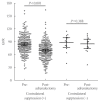Contralateral Suppression at Adrenal Venous Sampling Is Associated with Renal Impairment Following Adrenalectomy for Unilateral Primary Aldosteronism
- PMID: 34376041
- PMCID: PMC8419620
- DOI: 10.3803/EnM.2021.1047
Contralateral Suppression at Adrenal Venous Sampling Is Associated with Renal Impairment Following Adrenalectomy for Unilateral Primary Aldosteronism
Abstract
Background: Adrenal venous sampling (AVS) is performed to distinguish the subtype of primary aldosteronism (PA). The clinical implication of contralateral suppression (CS; aldosterone/cortisolnondominant<aldosterone/cortisolperipheral) at AVS remains unclear. We aimed to investigate the clinical significance of CS and its impact on postoperative outcomes after unilateral adrenalectomy.
Methods: In this retrospective observational multi-center study, we analyzed PA patients who underwent both successful adrenocorticotropin hormone-stimulated AVS and unilateral adrenalectomy. Successful cannulation was defined as the selectivity index (cortisoladrenal/cortisolperipheral) ≥3. Clinical and biochemical outcomes after unilateral adrenalectomy were evaluated based on the international Primary Aldosteronism Surgical Outcome consensus.
Results: Among 263 patients analyzed, 247 had CS (93.9%). Patients with CS had lower serum potassium levels, higher plasma aldosterone concentration, higher aldosterone-to-renin ratio (ARR), and larger adenoma size than those without CS. Those with CS showed significantly higher lateralization index than those without CS (P<0.001). Although postoperative blood pressure and ARR significantly decreased in those with CS, clinical and biochemical outcomes were comparable in both groups. When the cut-off value of age was determined using receiver operating characteristic (ROC) analysis, patients aged ≥50 years old with contralateral suppression index (CSI; the ratio between aldosterone/cortisolnondominant and aldosterone/cortisolperipheral) ≤0.26 had greater odds ratio (6.43; 95% confidence interval, 1.30 to 31.69) of incident chronic kidney disease than those aged <50 years with CSI >0.26 after adjusting for other factors.
Conclusion: CS may not predict postoperative clinical and biochemical outcomes in subjects with unilateral aldosterone excess, but it is associated with postsurgical deterioration of renal function in subjects over 50 years with CSI ≤0.26.
Keywords: Adrenalectomy; Glomerular filtration rate; Hyperaldosteronism; Hypertension; Phlebography; Treatment outcome.
Conflict of interest statement
No potential conflict of interest relevant to this article was reported.
Figures



Comment in
-
Contralateral Suppression at Adrenal Venous Sampling Is Associated with Renal Impairment Following Adrenalectomy for Unilateral Primary Aldosteronism (Endocrinol Metab 2021;36:875-84, Ye Seul Yang et al.).Endocrinol Metab (Seoul). 2022 Dec;37(6):951-952. doi: 10.3803/EnM.2022.1606. Epub 2022 Nov 25. Endocrinol Metab (Seoul). 2022. PMID: 36424735 Free PMC article. No abstract available.
-
Contralateral Suppression at Adrenal Venous Sampling Is Associated with Renal Impairment Following Adrenalectomy for Unilateral Primary Aldosteronism (Endocrinol Metab 2021;36:875-84, Ye Seul Yang et al.).Endocrinol Metab (Seoul). 2022 Dec;37(6):953-954. doi: 10.3803/EnM.2022.603. Epub 2022 Dec 12. Endocrinol Metab (Seoul). 2022. PMID: 36503216 Free PMC article. No abstract available.
Similar articles
-
Does contralateral suppression at adrenal venous sampling predict outcome following unilateral adrenalectomy for primary aldosteronism? A retrospective study.J Clin Endocrinol Metab. 2015 Apr;100(4):1477-84. doi: 10.1210/jc.2014-3676. Epub 2015 Jan 30. J Clin Endocrinol Metab. 2015. PMID: 25636049
-
Role of unilateral-cannulating adrenal venous sampling for the subtyping of primary aldosteronism for adrenalectomy: Experience from a low-volume center.World J Surg. 2024 Dec;48(12):2941-2949. doi: 10.1002/wjs.12402. Epub 2024 Nov 17. World J Surg. 2024. PMID: 39551645 Free PMC article.
-
Aldosterone suppression on contralateral adrenal during adrenal vein sampling does not predict blood pressure response after adrenalectomy.J Clin Endocrinol Metab. 2014 Nov;99(11):4158-66. doi: 10.1210/jc.2014-2345. Epub 2014 Aug 13. J Clin Endocrinol Metab. 2014. PMID: 25119314
-
Aldosterone-producing adenoma and other surgically correctable forms of primary aldosteronism.Orphanet J Rare Dis. 2010 May 19;5:9. doi: 10.1186/1750-1172-5-9. Orphanet J Rare Dis. 2010. PMID: 20482833 Free PMC article. Review.
-
Imaging Concordance With Vein Sampling for Primary Aldosteronism: A Cohort Study and Literature Review.J Surg Res. 2024 Apr;296:1-9. doi: 10.1016/j.jss.2023.11.029. Epub 2024 Jan 4. J Surg Res. 2024. PMID: 38181643 Review.
Cited by
-
Contralateral Suppression at Adrenal Venous Sampling Is Associated with Renal Impairment Following Adrenalectomy for Unilateral Primary Aldosteronism (Endocrinol Metab 2021;36:875-84, Ye Seul Yang et al.).Endocrinol Metab (Seoul). 2022 Dec;37(6):951-952. doi: 10.3803/EnM.2022.1606. Epub 2022 Nov 25. Endocrinol Metab (Seoul). 2022. PMID: 36424735 Free PMC article. No abstract available.
-
Contralateral Suppression at Adrenal Venous Sampling Is Associated with Renal Impairment Following Adrenalectomy for Unilateral Primary Aldosteronism (Endocrinol Metab 2021;36:875-84, Ye Seul Yang et al.).Endocrinol Metab (Seoul). 2022 Dec;37(6):953-954. doi: 10.3803/EnM.2022.603. Epub 2022 Dec 12. Endocrinol Metab (Seoul). 2022. PMID: 36503216 Free PMC article. No abstract available.
References
-
- Rossi GP, Bernini G, Calitype C, Desideri G, Fabris B, Ferri C, et al. A prospective study of the prevalence of primary aldosteronism in 1,125 hypertensive patients. J Am Coll Cardiol. 2006;48:2293–300. - PubMed
-
- Kayser SC, Dekkers T, Groenewoud HJ, van der Wilt GJ, Carel Bakx J, van der Wel MC, et al. Study heterogeneity and estimation of prevalence of primary aldosteronism: a systematic review and meta-regression analysis. J Clin Endocrinol Metab. 2016;101:2826–35. - PubMed
-
- Funder JW, Carey RM, Mantero F, Murad MH, Reincke M, Shibata H, et al. The management of primary aldosteronism: case detection, diagnosis, and treatment: an endocrine society clinical practice guideline. J Clin Endocrinol Metab. 2016;101:1889–916. - PubMed
-
- Monticone S, Viola A, Rossato D, Veglio F, Reincke M, Gomez-Sanchez C, et al. Adrenal vein sampling in primary aldosteronism: towards a standardised protocol. Lancet Diabetes Endocrinol. 2015;3:296–303. - PubMed
Publication types
MeSH terms
Substances
Grants and funding
LinkOut - more resources
Full Text Sources

